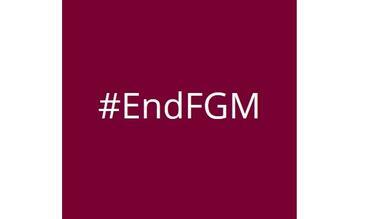
6th February is the International Day of Zero Tolerance for Female Genital Mutilation/Cutting (FGM/C). In the United Kingdom, the first conviction for FGM/C occurred in February 2019. It is a timely reminder that FGM continues to occur in many countries across the world.
Worldwide, about 200 million women and girls (including babies) are estimated to have undergone FGM/C.1These statistics are relatively abstract, and it is difficult to begin to understand the pain, trauma, and ongoing health issues that these women and girls experience as a result of FGM/C. Behind every statistic, there is a story of how FGM/C has affected a woman or young girl.
While it occurs throughout the world, the practice of FGM/C is concentrated in northern Sub-Saharan Africa and Asia. For example, in Somalia, Guinea, and Djibouti more than 90% of women and girls aged 15-49 years are living with FGM/C.2 In Gambia, 56% of babies and girls aged 0 to 14 years have undergone FGM/C.2
FGM/C involves either causing injury to or removing the female genital organs without a medical reason. Depending on context, it can be referred to as “cutting” or “female circumcision”. The emotional trauma caused by FGM/C is hard to measure but cannot be underestimated. Most importantly, FGM/C is a violation of human rights, including the right to health, and the rights of the child.3
Exactly what FGM/C entails differs between countries, communities, and families.
It usually includes one or more of:
- Cutting off the clitoris or the skin over it
- Cutting off the labia minora or majora
- Cutting off the labia minora and majora and then sewing them back together so they seal closed with scar tissue. This leaves just a small, sometimes tiny, opening at the vagina. This often must be cut open again or forced through for sexual intercourse and to give birth.
- Pricking, burning, cutting, or other harm caused to the clitoris or skin over it3
The type of FGM/C women and girls have endured can be hard to measure, and they might not even know themselves exactly what has happened. Most FGM/C is conducted by members of the community with no pain relief. Girls and women are often held or tied down. Sometimes girls die from the complications of the cutting such as bleeding or infection and sepsis.
The list of short- and long-term problems associated with FGM/C includes: recurrent infection, not being able to pass urine and chronic pain.4 Women and girls with FGM/C are also more likely to develop anxiety, depression and/or post traumatic stress disorder.4 Those with FGM/C, especially the most extreme types, are more likely to have trouble when they give birth, including long labours, bad vaginal tears, babies with breathing problems after birth, and stillbirths.4
Why does FGM/C continue to be conducted?
This is complicated. FGM/C is rooted in gender inequality – basically, unfair treatment just because they are female.5 The exact reasons differ between countries, communities, and families but usually involve one or of the below:5
- Cultural beliefs/norms: FGM/C is considered an “initiation” into womanhood, or “necessary for marriage” in a context where marriage is often necessary to survive.
- Religious beliefs: Most widely practiced by Muslims, but also some Christians and other religions support the continuation of FGM/C.
- Hygiene and appearance: Normal female genitalia may be considered “dirty" or "ugly”.
- Psychosexual: To “control” female sexuality, to stop a woman enjoying sex, to ensure virginity at marriage and/or to increase male pleasure.
We know that stopping FGM/C requires commitment by everyone involved.6 It will entail a lot of hard work, but every girl saved from FGM/C is worth it.
Here at LSTM in the Centre for Maternal and Newborn Health, Dr Mary McCauley and Professor van den Broek have published an editorial in International Health outlining both the challenges around ending FGM/C and the importance of doing so. Dr McCauley has also written a mini-commentary in BJOG highlighting that despite its devastating impact and documented adverse health outcomes for young girls and women, the practice of FGM/C sadly continues to this day: The global challenge to improve the sexual and reproductive health of women affected by FGM/C.
The Centre for Maternal and Newborn Health continues its work towards improving the health of all women, including those with FGM/C. Let’s use this International Day of Zero Tolerance for Female Genital Mutilation as an opportunity to reflect on how we can all be part of ending FGM/C.
About the author
Joanne Gerrell, usually know as Annie, is a registered nurse midwife from Australia. While volunteering in Papua New Guinea she realised the impact that accessible and quality maternal healthcare can have and is therefore currently completing a MSc in International Public Health (Sexual and Reproductive Health) at LSTM.
References
1. World Health Organization (2017) Female Genital Mutilation. Available at https://www.who.int/reproductivehealth/topics/fgm/prevalence/en/(Accessed: 4 February 2019).
2. UNICEF (2016) Female Genital Mutilation/Cutting: A Global Concern. Available at https://www.unicef.org/media/files/FGMC_2016_brochure_final_UNICEF_SPREAD.pdf (Accessed: 4 February 2019).
3. World Health Organization (2008) Eliminating female genital mutilation: An interagency statement. Geneva, Switzerland: World Health Organization. Available at https://apps.who.int/iris/bitstream/handle/10665/43839/9789241596442_eng.pdf (Accessed: 4 February 2019).
4. World Health Organization (2008) Health risks of female genital mutilation (FGM). Available at https://www.who.int/reproductivehealth/topics/fgm/health_consequences_fgm/en/ (Accessed: 4 February 2019).
5. UNFPA (2018) Female genital mutilation. Available at https://www.unfpa.org/resources/female-genital-mutilation-fgm-frequently-asked-questions#psychological_effects (Accessed: 4 February 2019).
6. McCauley, M. & van den Broek, N. (2019) ‘Challenges in the eradication of female genital mutilation/cutting’, International Health, 11(1), pp. 1-4. doi: 10.1093/inthealth/ihy082. Available at https://academic.oup.com/inthealth/article/11/1/1/5146303 (Accessed: 4 February 2019).